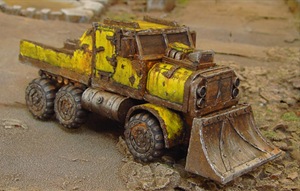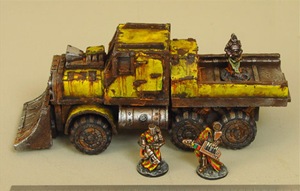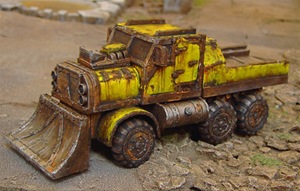I recently got hold of a large number of second-hand Gorkamorka models, a find I am still very pleased with. However, in the majority of cases, second hand models are painted. Sometimes the paintjobs are excellent, other times atrocious. However, I prefer to paint my own miniatures, so I usually strip them.
There’s a variety of different ways to strip paint, but my preference is Dettol. It’s not too expensive and doesn’t take very long. It also works on both plastic and metal, which is more than can be said for lots of the other methods I’ve heard of. Brake fluid, for example, apparently takes a week or two to strip the models. Seriously? 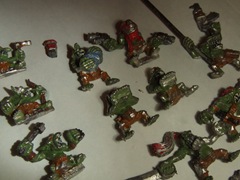 A few days is too slow in my view. Thankfully Dettol strips the paint in a matter of hours.
A few days is too slow in my view. Thankfully Dettol strips the paint in a matter of hours.
There are a few caveats – Dettol will not dissolve superglue, which may prevent paint coming off in some areas. Remove the superglue and then try again. This may well be a non-issue if the models were assembled then painted, but it does come up.
The Rebel Grots in the photo were left in nail varnish remover for a few days as an experiment – it removed some of the paint, but wasn’t particularly effective. So, they’re going in the Dettol!
Step one: Fill a receptacle with models to strip
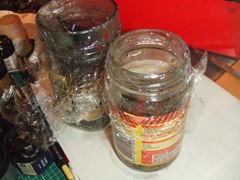 For individual figures and components I use jars, for vehicles I use ice cream tubs.
For individual figures and components I use jars, for vehicles I use ice cream tubs.
Fill the jar as much or as little as you like with pieces. In the photo the larger jar is for metal vehicle components (there’s most of a Big Lugga in there, for example).
Once you’ve got the stuff you’d like in the jar, cover it in undiluted Dettol. It doesn’t need to be immersed to any great depth, just enough to cover the bits will be fine.
Cover the top with clingfilm (“Plastic wrap”) and leave overnight. Or for a few hours, really. You’ll be able to see the paint coming off, so it’s easy to gauge how things are going.
Step two: Safety Gear
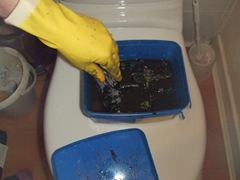 The next bit isn’t essential, but given that Dettol is kinda poisonous, it’s probably best to be careful. I wear gloves when dealing with the models and for preference a gas mask, but as long as you’re in a reasonably well ventilated area you should be okay, just don’t treat it like a sauna.
The next bit isn’t essential, but given that Dettol is kinda poisonous, it’s probably best to be careful. I wear gloves when dealing with the models and for preference a gas mask, but as long as you’re in a reasonably well ventilated area you should be okay, just don’t treat it like a sauna.
If you do get a little Dettol on you don’t worry, the problem comes when your fingers spend several minutes covered in the stuff. You’ll get numb and your skin will prune. Then it’ll stay that way for a few days, which gets pretty tiresome I can tell you.
As there’s going to be bits of paint everywhere, I recommend you strip the models over a sink or bathtub, something that is easy to wipe down. The stuff gets everywhere, so a sink is ideal.
Step three: Scrubbing
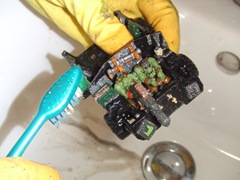 Fish out one of the models in the solution and grab an old toothbrush. Holding it in the sink, gently scrub at the model. The paint should come away in stringy, sticky chunks. It’s a little hard to describe, but you’ll see what I mean when you try it.
Fish out one of the models in the solution and grab an old toothbrush. Holding it in the sink, gently scrub at the model. The paint should come away in stringy, sticky chunks. It’s a little hard to describe, but you’ll see what I mean when you try it.
Most of the paint should come away easily. If it doesn’t, put the model to one side and continue on. You can then stick the models that weren’t stripped enough in the jar for a second round of stripping. It’s worth mentioning that you can reuse the same Dettol for this.
Step four: Rinsing
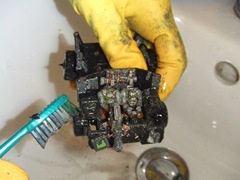 Once you’re certain you’re done scrubbing at the models, rinse them in warm water. You can scrub at them as you do this, if you feel they need it. However don’t use the same toothbrush to scrub at them during this as the paint flecks will stick to the model.
Once you’re certain you’re done scrubbing at the models, rinse them in warm water. You can scrub at them as you do this, if you feel they need it. However don’t use the same toothbrush to scrub at them during this as the paint flecks will stick to the model.
Leave the models to dry somewhere and they should be ready to paint. Those that didn’t get fully stripped should be put through this process again, perhaps with a fresh toothbrush. I bought a big pack of them at a rather tatty discount shop for this very purpose.
…and you’re done.
As you can see, the result isn’t too bad and the plastic isn’t warped.
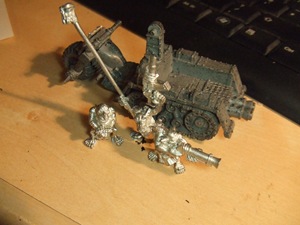

I’ve got a whole load more to strip, so I’m going to get back to work!










